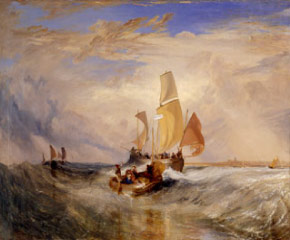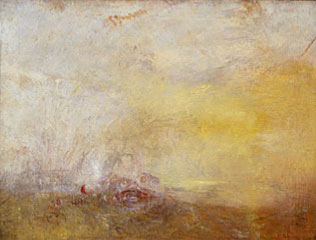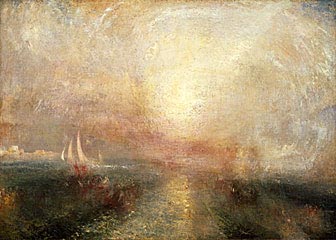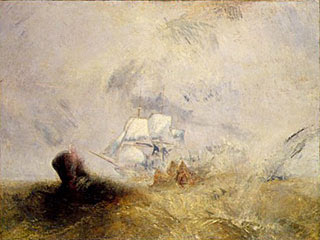
june 14–september 7, 2003

Image Gallery










The Marine Painter
Turner was one of the great maritime painters of his day, his oils and watercolors representing the sea and seacoast in all its aspects and moods. While his works are invariably innovative and original, they sometimes show a profound debt to earlier traditions of maritime painting. Turner was especially influenced by the seascapes of such seventeenth-century Dutch artists as Jan van Goyen and Jacob van Ruisdael, with their combination of acute naturalism and romantic sensibility.
Channel Crossings
Turner was an inveterate traveler throughout his life, frequently crossing the English Channel to trek over the Alps to Italy. During these journeys he painted constantly, seeking in his watercolors to capture a sense or mood of a locale as much as topographical accuracy. His views of the continent, from the breathtaking lakes of Switzerland to the sun-dappled canals of Venice, exemplify his fascination with the effects of sky, water, and reflection.
The Sea Imagined
For an island nation the sea was both a fact of life and a fantastic realm of the imagination, a setting for mythical legends and human dramas. Its uncontrollable and unpredictable power was an apt metaphor, whether for biblical narratives or the political instability of Europe in the 1840s. It was also a good theme for artistic experimentation, and Turner used his knowledge of color theory and the emerging technology of photography to create works of groundbreaking originality.
The Sea Encountered
For Turner, the sea was an immensely powerful and potentially dangerous element, a force of nature that should be approached with proper caution. Many of his paintings evoke the dangers of the sea and attempts by human beings to constrain them. The broad brushstrokes and vivid colors that he employed, though often criticized during his lifetime, seem the perfect technique to represent the turbulence of waves and the changeability of weather.
The Deep
As Turner grew older, his style became more expressive and nearly abstract. The specificity of his earlier art gave way to paintings that were less about representing particular locations or events and more about capturing a mood or, as the critic John Ruskin put it, "the conveyance of a feeling." Turner continued to represent the subjects that had always intrigued him—biblical and classical narratives, the power of wind and water, the Dutch seapiece—but with a newfound luminosity and grandeur.